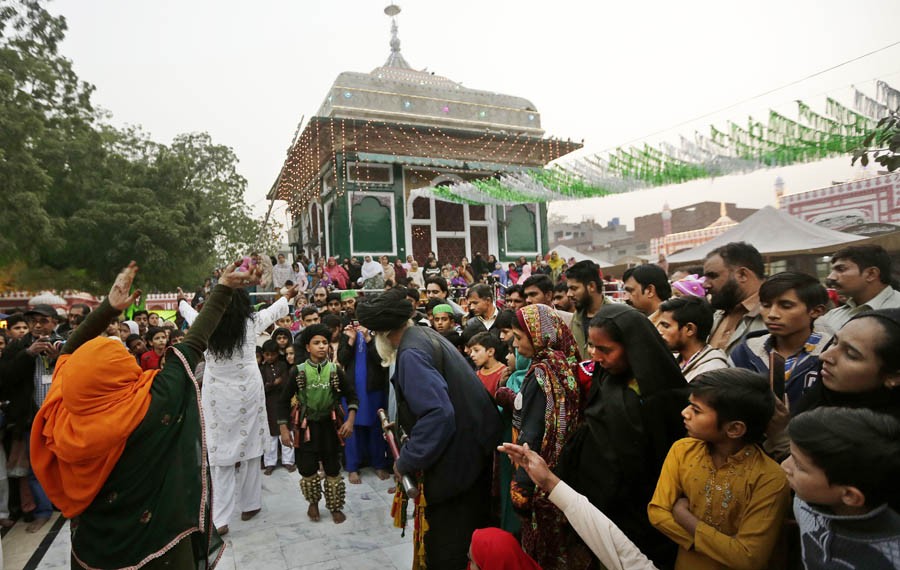
Shrines have presented themselves as places offering acceptance to communities living outside the rigid gender binaries

In the land of rifts and rampant marginalisation on the basis of any kind of difference, shrines have been presenting themselves as places offering acceptance to communities living outside rigid gender binaries.
Claiming a distinctive gender identity, which doesn’t fit a gender stereotype exposes hijras (eunuchs) to multiple forms of oppression and exclusion. Being the third gender, they suffer through the institutionalised cis-normative and trans-exclusionary culture of gender: two bathrooms, two sections in the bus, two boxes on the application form, two lines in the government offices, one for men and one for women.
Majority of trans people are thus forced to live only in certain sections of the city and their mobility is severely restricted. Yet, on the other hand, shrines have always been an oasis of acceptance and respect for the khawajasaras of the sub-continent. Even today, at many such places, only a hijra can put the first chaadar (shawl) on the grave of a saint, or it is hijras who lead the maatam -- the ritual lamentation -- in the women section of shrines.
A khwajasarah guru and activist, Aashi Jaan states, "In the past, the khawajasaras were given a relatively respectable and sacred position, especially in the Sufi tradition. We still find such people at shrines who tremendously respect us, but their number has decreased over time."
Jaan says that even today, they have sustained the ritual of going to shrines every Thursday to pray for themselves and the people who have asked them to pray for them.
The word "hijra" has roots in the word "hijr" meaning, to migrate -- designating a ‘neither here, nor there’ status; neither man, nor woman, somewhere in the middle or beyond, liminal in other words. The performance of rituals in Sufi traditions has always given space to liminality where ambiguous bodies are given a special sacred place designating purity or a spiritual status.
Amen Jaffer, an anthropologist considers fakiri -- creation of the spiritual gendered self -- a powerful concept for hijras to mobilise a spiritual vision of the self and to demand recognition for their gender identity.
He says, "Fakiri is also a radical act of love. It is born out of the intensity of spiritual love, which renders one incapable of functioning in society. Thus, identifying as a fakir enables the hijras to make sense of their social position in spiritual terms.’’
An anthropologist and researcher at LUMS, Mehlab Jameel reflects on her experience, "Based on the time I have spent with the local khawajasara community in Lahore, particularly those who are regular shrine-goers, I have observed how shrines and dargahs occupy an essential space for expressing devotion, practising rituals mired in Sufi traditions and mythology, formulating a bodily ethic of piety, and constructing moral selves in the shared imagination among the people who complicate gender binaries and traverse rigid boundaries.
"Sometimes this space also provides a way of understanding one’s own position in the society through encounters with people of common experience in that space."
However, shrines, like any other urban space, have also always been dynamic and confronted with the necessity to change or adapt. In the past decade or so, our cities have rapidly transformed and expanded under a regime of ‘security development’. In response to the threats and actual harm caused by militant outfits to shrines, the state discourse about ‘counter-terrorism’ has strongly affected the spatial orientation of shrines themselves.
So, a place where you could go to regardless of who you are, how you present yourself, or who you associate with, has now got big, burly, moustached guards and policemen muttering into their walkie-talkies and frisking anyone who passes by. There are giant grills and barriers installed at entrances with guns pointing at you. Any agent perceived as ‘hostile’ is heavily scrutinised, searched, and apprehended. Naturally, a community like khawajasara that has existed on the margins and has mostly been shrouded in mystery and myths often becomes that ‘suspicious’ element. They might be subjected to invasive bodily searches and interrogations. They become the threat because of their ambiguity.
Not only has the access to shrines become difficult, especially for a marginalised person, the space of the shrine has also transformed to exclude ‘others’. The gender segregation at Data Darbar is, perhaps, a good example of how the city administration emulates gender hierarchies through security measures.
Jameel states that "The element of shedding all your identities and entering a sacred space that allows everyone in, regardless of class, gender or caste has slowly been replaced by a city administrative regime that installs these very systems of division into the city spaces. In this way, the inclusive space of the shrine starts reinforcing hierarchies through methods of exclusion."